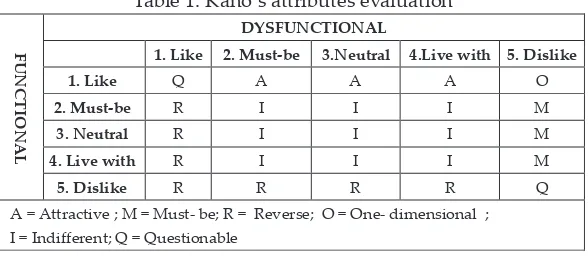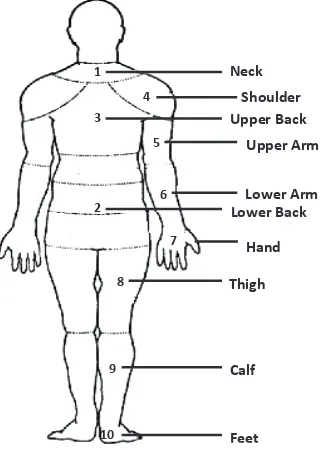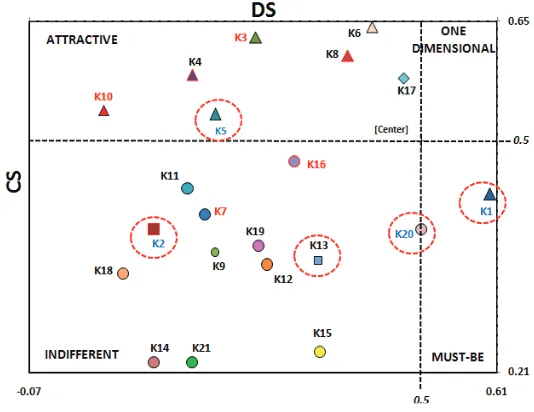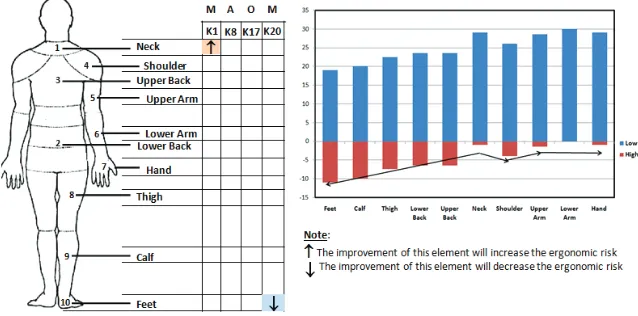ISSN: 1985-3157 Vol. 8 No. 2 July - December 2014 61 KANO MODEL APPROACH FOR DESIGN IMPROVEMENT
ASSOCIATED WITH ERGONOMICS ISSUES IN CNC MACHINE DESIGN
H., Sihombing1, I., Halim2, M.A., Rahman3, B., Abu Bakar4 and S.K., Khalid5 1,2,3,4,5Faculty of Manufacturing Engineering,
Universiti Teknikal Malaysia Melaka, Hang Tuah Jaya, 76100 Durian Tunggal, Melaka, Malaysia
Email: *1[email protected]; 2[email protected];
3[email protected]; 4[email protected];
ABSTRACT: Application of Computer Numerical Control (CNC) technology in manufacturing industry has been recognized as one of
the efective solutions to high productivity, eiciency, and precision.
In advancement of CNC machine tool technology development; however, the ergonomic issues related to human-machine design are still less-addressed by scholars. This study was carried out to analyze a CNC machining center based on the operators’ requirements. The functional and dysfunctional questionnaire form developed based on Kano method was applied to determine
the operators’ requirements related to technical speciications of
the CNC machining center. Another questionnaire form equipped with a diagram of human body parts and ergonomics features was used to acquire information on the CNC machining center design.
This study found that there is a signiicant correlation between the
ergonomics problems in the feet towards facilities required for the CNC machining center – an adjustable standing platform. This study concluded that application of Kano model can contribute to operators’ satisfaction in terms of ergonomic design of CNC machining center.
KEYWORDS: CNC Machine, Ergonomics Issues, Kano Model
1.0 INTRODUCTION
interlocks on CNC machine (which is as commonplace across the UK engineering industry), it is found that the problems of most machine design in operators’ requirements are not only due to visibility, usability, and accessibility issues. They include people’s subjective feeling to the preference and needs in the design of CNC machine tools [3].
Based on the above reason, the company management has to consider both physical and psychological of CNC machine operators, as these
factors can afect the productivity performance [4]. The focus is on how
the company creates conditions for users to take part in the designing of product in actively [3] as well as through implementing the cooperation
between the diferent scientiic ields, people, techniques, backgrounds,
views, and so on (i.e., risk perception, knowledge of risks, machine design, and procurement) [2]. In addition, the companies should
think that there is a botom-line tradeof between safety and eiciency where they embrace ergonomics [5]. This is as shown on the efects
of training on CNC machine, in which the results show that the CNC operator can perceive more correctly a hazardous condition based on psychophysical [6]. Also, this is an essential basis to reduce the risk of failures in operation as well as physical complaints such as back pain due to awkward body posture during work [7] where the people-oriented principle must be held in the design of hardware human-man interface [3].
To address this issue, this study was performed to investigate the machine’s operators satisfaction related to CNC machine design. Additionally this study analyzed the CNC machine characteristics related to prevalent ergonomics problems as well as the improvement required.
2.0
KANO APPROACH TOWARDS CUSTOMER
SATISFACTION AND IMPROVEMENT
Kano brings a fresh quantitative Voice of the Customer (VOC) data
to the inal feature set decision process towards the product atributes
ISSN: 1985-3157 Vol. 8 No. 2 July - December 2014 63 I = Indifferent; Q = Questionable
To depict the customer standpoint towards satisfaction based on Kano
atributes, the customer satisfaction index (CSI) based on the rate of CS (satisied customers) if the atribute is present and DS (dissatisied customers) if the atribute is absent or insuicient [9]. The quality atribute is classiied as ‘A’ (Atractive) if CS > 0.5 and DS < 0.5; ‘M’
(Must-be) if DS ≥ 0.5 and CS ≥ 0.5; ‘O’ (One-Dimensional) if CS > 0.5
and DS > 0.5; and Indiferent (I) or Neutral if CS < 0.5 and DS < 0.5. The CS and DS coeicient are shown as follows:≥ ≥
CS and DS coefficient are shown as follows:
improvement ratio is m = max (|CS|,|DS|) in which the Ka
• Satisfaction index based on CS
=
• Dissatisfaction index based on DS =
-The improvement ratio is m = max (|CS|,|DS|) in which the Kano category is found through CS-DS plot [10]. By manipulating into four quadrants, they are parallel to Importance-Performance Analysis (IPA)
for customer satisfaction [11]. The quadrant 1 (Q1) represents ‘Low Priority’ (Low Importance – Low Satisfaction), the quadrant 2 (Q2) represents ‘Possible Overkill’ (High Importance – Low Satisfaction), the quadrant 3 (Q3) represents ‘Keep Up the Good Work’ (High
Importance-High Satisfaction), and the quadrant 4 (Q4) represents
‘Concentrate Here’ (Low Importance-High Satisfaction). Yang [12] articulated Q1 as ‘Care-free’, Q2 as ‘Surplus’, Q3 as ‘Excellent’, and Q4 as ‘To be improved’. The diference between CS-DS approach to
both approach is, however, the center point of the quadrant that is
based on the mean values between ‘Importance’ and ‘Performance’ or ‘Satisfaction’ values. In addition, through the approach of using the
graph, there are some contradictions since the Kano approach is not
ISSN: 1985-3157 Vol. 8 No. 2 July - December 2014 64
3.0
METHODOLOGY
This study performed a survey among 30 CNC machine operators.
They had working experience more than ive years in CNC machining
operation. This study applied a questionnaire that contains of ergonomics problems in the body parts (Figure 1), ergonomics features requirements and failure experiences of using CNC, the usability criteria, critical components of CNC, and control components of CNC
(Table 2). This study also applied Kano approach to analyze the ‘what’ improvement required based on quality atributes related to ergonomics
issues and technical requirements of CNC machine (Table 2).
5 ent
Figure 1: Area of pain due to ergonomics issues
Table 2: Type of failures and critical CNC machine facilities ERGONOMICS FEATURES REQUIREMENT CRITICAL PART OF CNC COMPONENT CONTROL
COMPONENTS
1 Adjustable Working height 1 Base 1 Buttons
2 Adjustable control panel 2 Saddle / Table 2 Switches
3 Wheel chair for disable person 3 Cutting Tools 3 Indicators
4 Adjustable right lever 4 Accessories 4 Sensors
5 Adjustable tool holder – horizontal movement 5 Actuators
6 Adjustable machine table 6 Computer
Controllers
3 3
ISSN: 1985-3157 Vol. 8 No. 2 July - December 2014 65
FREQUENT FAILURE
EXPERIENCED USABILITY CRITERIA
1 Overload Fracture 1 Are the controls of the machine are difficult to be reached and
controlled?
2 Wear & Tear 2 Are the control of the machine are placed where they are difficult
to be seen?
3 Corrosion (Rusting) 3 Does the task require a fine visual judgment?
4 Thermal Failure 4 Are the warning lights of machine located far away from the
center field of vision?
5 Chipping
6 Looseness
4.0
RESULTS
Figure 3 shows the K2 (voice command control) and K13 (QC facility
measurement and monitoring) which are ‘Reverse’ atributes that is located in Quadrant 1. The K20 (adjustable height) (Indiferent) that
was located in Quadrant 1 was not in the right location. Therefore, the adjustment for center point would revise the center from (0.5; 0.5)
to 0.54 and 0.43 (Figure 3). By this adjustment, only K13 in ‘Reverse’ atribute. The quality atribute of ‘Reverse’ and ‘Questionable’ is able to
ignore the graph approach of CS versus DS [9]. Through Satisfaction graph approach – as an adaptation of Importance-Performance [10], Figure 2 shows the K3 (Probing system for tools
seting and monitoring the dimensional accuracy) is ‘Excellent’. The diference is on Quadrant 2 that represented ‘Surplus’ or ‘Over Kill’ criteria (K5 – tool wear detection system; K18 – control panel atached to machine frame; K21 – buton to adjust the standing platform versus
K4 – camera for remote monitoring; K5 - tool wear detection system;
important.
Figure 3: Customer satisfaction vs. customer dissatisfaction
Figure 2: Customer satisfaction vs. customer dissatisfaction
ournal of Advanced Manufacturing Technology
Figure 4: Adjustment customer satisfaction vs. customer dissatisfactio
Figure 3: Adjustment customer satisfaction vs. customer dissatisfaction
This study found that most of the quality atributes (machine emergency stop buton, machine monitoring facility, machine operation facility,
machine control panel, and machine platform construction) had positive
ISSN: 1985-3157 Vol. 8 No. 2 July - December 2014 67
accessories component of CNC machine towards K1 and K20 quality
atributes. As for the K8 (3D cuting software), that is ‘Atractive’ to the machine operators, it had an insigniicant correlation with ergonomic
problems.
Moreover, by inventing the CNC machine with the K17 (adjustable
control panel vertically), the problems that can be addressed are ‘Wear & Tear, Thermal, and Looseness’. Most of the failure experiences had a positive signiicant correlation with control components. The ergonomic requirement like ‘Adjustable Tool Holder’ and ‘Adjustable Machine Table’ mostly had a signiicant correlation with ‘Lower Back’
towards ergonomic problems, between low and high fatigue (low fatigue = light fatigue + moderate fatigue; high fatigue = very fatigue + extreme fatigue). This study found that the CNC machine operators
sufered on the feet area; followed by calf, thigh, lower back, and upper
back (Figure 4).
calf, thigh, lower back, and upper back (Figure 5).
Figure 5: Kano of quality improvement required vs. ergonomics risk
Figure 4: Kano of quality improvement required vs. ergonomics risk
The elements of CNC machine which need further improvement are
K1 (red press buton), K8 (3D cuting software), K17 (adjustable control
panel), and K20 (adjustable height of standing platform). However, priority should be given to the adjustable height of standing platform in order to reduce the risk of ergonomics problems on feet.
5.0
CONCLUSION
There are signiicant correlations between quality atributes of CNC
machine with ergonomics problems. This study concludes that the
standing platform) as it has a signiicant correlation to reduce ergonomics
problems in the feet. To determine the priority improvement required, this study proposes a utilization of graph CS vs. DS by the adjustment
and the graph of ‘Importance’ vs. ‘K*(CCS-DS)’. Both graphs show the consistencies for what elements of the required quality atributes need
to be improved. However, further investigation is required towards the ergonomics problems interpreted in the graph based on importance and satisfaction.
ACKNOWLEDGMENTS
The authors would like to thank the Faculty of Manufacturing Engineering and the Universiti of Teknikal Malaysia Melaka (UTeM) for funding this project under Center of Excellent research fund (PJP/2012/
AMC/Y00005). The authors would also like to thank Impressive Edge
(M) Sdn. Bhd., Melaka for the permission of data collection.
REFERENCES
[1] T. Retsch, , G. Schmiter, A. Marty, “Safety principles for CNC
machine tools”. Stellman, J.M (Eds) Encyclopedia of Occupational Health and Safety. 4th ed., vol.II, International Labour Organization. Geneva,
2011.
[2] Hopkinson and Lekka, “Identifying the human factors associated
with the defeating of interlocks on Computer Numerical Control (CNC) machines”, The Health and Safety Executive Research Report, No.
RR974 (06/13), 2013.
[3] T. Ye, T. Zuo, “Ergonomics research and CNC machine tools in the
interface design of the application”, 9th International Conference of
Computer-Aided Industrial Design and Conceptual Design (CAID/CD), 22-25 Nov, 2008, pp.73-77, 2008.
[4] S. F. Wong, Z. X. Yang, “Numerical Ergonomics Analysis in Operation
Environment of CNC Machine”, The 12th International Conference on
Enhancement and Promotion of Computational Methods in Engineering and Science (EPMESC XII), November 30 – December 3, Hong Kong –
Macau, 2009.
[5] I. A. Khan, “Ergonomic design of human-CNC machine interface. Maurtua, I. (Eds). Human Machine Interaction –Geting Closer,
INTECH, 2012.
[6] V. G. Dufey, “Efects of training and experience on perception of
ISSN: 1985-3157 Vol. 8 No. 2 July - December 2014 69 [7] I. Levchuck, A. Schäfer , K-H. Lang, Hj. Gebhardt ,A. Klussmann, “Needs of ergonomic design at control units in production industries”, Work, vol. 41, 1594-1598, 2012.
[8] N. Kano, N. Seraku, F. Takahashi, S. Tsuji, “Atractive quality and
must-be quality”, Hinshitsu The Journal of the Japanese Society For Quality Control, 39-48, 1984.
[9] C. Berger, R. Blauth, D. Boger, C. Bolster, G. Burchill, W. DuMouchel, F. Pouliot, R. Richter, A. Rubinof, D. Shen, M. Timko, D. Walden, “Kano’s methods for understanding customer-deined quality”, Center for Quality Management Journal, vol. 2, no. 4,3-35, 1993.



